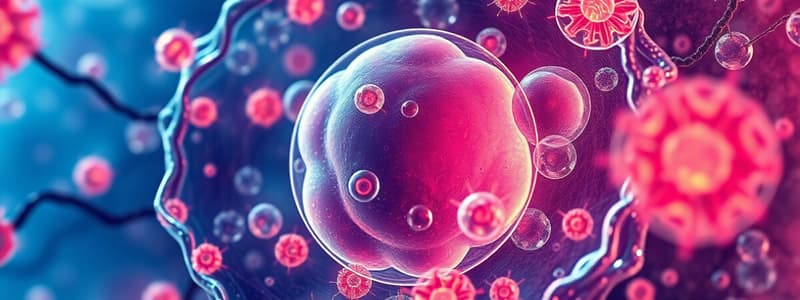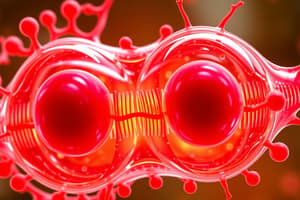Podcast
Questions and Answers
What is the primary function of carrier proteins in the cell membrane?
What is the primary function of carrier proteins in the cell membrane?
- To form channels for passive diffusion of ions only
- To provide structural support to the membrane
- To act only in endocytosis processes
- To bind to a molecule, change shape and transport it across the membrane (correct)
Which process describes the movement of molecules against their concentration gradient?
Which process describes the movement of molecules against their concentration gradient?
- Osmosis
- Facilitated diffusion
- Active transport (correct)
- Passive transport
In which phase of the cell cycle does DNA replication occur?
In which phase of the cell cycle does DNA replication occur?
- Mitosis
- G2 phase
- G1 phase
- S phase (correct)
During which process do two genetically identical daughter cells result from a single cell?
During which process do two genetically identical daughter cells result from a single cell?
What happens during prophase in the mitotic phase?
What happens during prophase in the mitotic phase?
What is the primary function of cardiac muscle?
What is the primary function of cardiac muscle?
Which component of the heart prevents blood from flowing backwards?
Which component of the heart prevents blood from flowing backwards?
What is the role of alveoli in the respiratory system?
What is the role of alveoli in the respiratory system?
During inspiration, what happens to the diaphragm?
During inspiration, what happens to the diaphragm?
Which type of tissue is responsible for communication and sensory sensation within the body?
Which type of tissue is responsible for communication and sensory sensation within the body?
What characterizes the connective tissue in the human body?
What characterizes the connective tissue in the human body?
What is the main purpose of the epithelial cells lining the trachea and bronchi?
What is the main purpose of the epithelial cells lining the trachea and bronchi?
Which layer of the skin is primarily made of muscle, nervous, and connective tissues?
Which layer of the skin is primarily made of muscle, nervous, and connective tissues?
What is the role of the centromere during metaphase?
What is the role of the centromere during metaphase?
Which process occurs directly after anaphase?
Which process occurs directly after anaphase?
What distinguishes adult stem cells from embryonic stem cells?
What distinguishes adult stem cells from embryonic stem cells?
What type of potency does a totipotent stem cell have?
What type of potency does a totipotent stem cell have?
What is the main function of epithelial tissue?
What is the main function of epithelial tissue?
How does cytokinesis differ in animal cells compared to plant cells?
How does cytokinesis differ in animal cells compared to plant cells?
What is the primary characteristic of maristematic cells in plants?
What is the primary characteristic of maristematic cells in plants?
What is a key feature of tissues in the context of organ formation?
What is a key feature of tissues in the context of organ formation?
What is the primary role of the cell membrane?
What is the primary role of the cell membrane?
Which organelle is primarily responsible for energy production through cellular respiration?
Which organelle is primarily responsible for energy production through cellular respiration?
What distinguishes rough ER from smooth ER?
What distinguishes rough ER from smooth ER?
What is the function of lysosomes?
What is the function of lysosomes?
What is the main purpose of vacuoles in plant cells?
What is the main purpose of vacuoles in plant cells?
Which statement correctly defines osmosis?
Which statement correctly defines osmosis?
Which type of environment has a higher concentration of solute than the inside of a cell?
Which type of environment has a higher concentration of solute than the inside of a cell?
In terms of transport, what is a key characteristic of active transport?
In terms of transport, what is a key characteristic of active transport?
What is the primary function of the Golgi apparatus?
What is the primary function of the Golgi apparatus?
What structure within the nucleus is primarily responsible for the production of ribosomes?
What structure within the nucleus is primarily responsible for the production of ribosomes?
Flashcards
Pore Protein
Pore Protein
A protein that forms a tunnel through the cell membrane, allowing specific molecules or ions to pass through.
Carrier Protein
Carrier Protein
A protein that binds to a molecule, changes shape, and transports it across the membrane.
Active Transport
Active Transport
Movement of molecules across a membrane against their concentration gradient, requiring energy.
Endocytosis
Endocytosis
Signup and view all the flashcards
Mitosis
Mitosis
Signup and view all the flashcards
Sister Chromatids
Sister Chromatids
Signup and view all the flashcards
Metaphase
Metaphase
Signup and view all the flashcards
Anaphase
Anaphase
Signup and view all the flashcards
Totipotent Stem Cell
Totipotent Stem Cell
Signup and view all the flashcards
Regeneration
Regeneration
Signup and view all the flashcards
Stem Cell
Stem Cell
Signup and view all the flashcards
Pluripotent Stem Cell
Pluripotent Stem Cell
Signup and view all the flashcards
Multipotent Stem Cell
Multipotent Stem Cell
Signup and view all the flashcards
Cell Membrane
Cell Membrane
Signup and view all the flashcards
Cell Wall
Cell Wall
Signup and view all the flashcards
Ribosomes
Ribosomes
Signup and view all the flashcards
Cytoplasm
Cytoplasm
Signup and view all the flashcards
Cytoskeleton
Cytoskeleton
Signup and view all the flashcards
Endoplasmic Reticulum (ER)
Endoplasmic Reticulum (ER)
Signup and view all the flashcards
Golgi Apparatus
Golgi Apparatus
Signup and view all the flashcards
Lysosomes
Lysosomes
Signup and view all the flashcards
Mitochondria
Mitochondria
Signup and view all the flashcards
Nucleus
Nucleus
Signup and view all the flashcards
What is muscle tissue?
What is muscle tissue?
Signup and view all the flashcards
What is the function of the heart?
What is the function of the heart?
Signup and view all the flashcards
What is nervous tissue?
What is nervous tissue?
Signup and view all the flashcards
What is connective tissue?
What is connective tissue?
Signup and view all the flashcards
What is the dermis?
What is the dermis?
Signup and view all the flashcards
What is the respiratory system?
What is the respiratory system?
Signup and view all the flashcards
How does inspiration work?
How does inspiration work?
Signup and view all the flashcards
How does expiration work?
How does expiration work?
Signup and view all the flashcards
Study Notes
Cell Membrane
- Covers the cell, acting as a gatekeeper for materials entering and exiting.
- Double layered, semi-permeable.
Cell Wall
- Rigid structure that surrounds, protects, and supports.
- Primarily found in plant cells.
- Composed of cellulose.
Ribosomes
- Small protein structures involved in cell division.
- Found in both plant and animal cells.
Chloroplast
- Organelle containing chlorophyll, essential for photosynthesis.
- Found in plant cells.
DNA
- Threadlike structure containing genetic information (hereditary).
Cytoplasm
- Region within the cell containing organelles.
- Where nutrients are absorbed, transported, and processed.
- Mostly water.
Cytoskeleton
- Network of protein fibers supporting cell shape.
- Enables movement of cell components.
Endoplasmic Reticulum (ER)
- Series of canals/membranous structures.
- Involved in transporting materials through the cell.
- Two types:
- Rough ER: Has ribosomes, makes proteins.
- Smooth ER: No ribosomes, makes fats/lipids.
Golgi Apparatus
- Stores and modifies proteins for use inside or outside the cell.
- Collects and processes materials.
- Involved in secretion, such as mucus production.
Lysosomes
- Sac-like structures containing enzymes that break down large molecules.
- Found in animal cells.
Mitochondria
- Powerhouse of the cell generating energy via cellular respiration.
- Oval-shaped organelles, found in animal cells.
Nucleus
- Control center of the cell containing DNA.
- Directs cell activities and protein synthesis.
- Contains chromosomes.
Ribosome
- Organelles responsible for building proteins.
Vacuoles
- Small membrane-bound compartments for storing water, wastes, etc.
- Larger in plant cells.
Passive Transport
- Movement of molecules across a semi-permeable membrane without energy.
- Includes: diffusion, facilitated diffusion, osmosis.
Active Transport
- Movement of molecules against the concentration gradient, requiring energy.
- Uses carrier proteins for transport.
Diffusion
- Movement of molecules from high to low concentration until equilibrium is reached.
Facilitated Diffusion
- Diffusion aided by protein channels or carrier protein.
Osmosis
- The diffusion of water across a semi-permeable membrane from high to low concentration of water.
Endocytosis
- Bulk transport of materials into the cell.
Exocytosis
- Bulk transport of materials out of the cell.
Asexual Reproduction
- Offspring genetically identical to the parent.
Sexual Reproduction
- Combining genetic material from two parents to create offspring.
Cell Cycle
- Series of phases cells undergo to grow, duplicate DNA, and divide.
Mitosis
- Cell division resulting in two genetically identical daughter cells. Phases include Prophase, Metaphase, Anaphase, Telophase, Cytokinesis.
Cellular Specialization
- Cells adapt to specific functions.
Stem Cells
- Unspecialized cells with the potential to differentiate into various cell types.
Types of Stem Cells
- Totipotent, Pluripotent, Multipotent.
Epithilial Tissues
- Protective outer layers of organs and surfaces.
- Contains thin layers of packed cells.
Muscle Tissues
- Involved in movement. Types include skeletal, smooth, and cardiac muscle.
Nervous Tissues
- Conducts electrical impulses, essential for communication.
Connective Tissues
- Supports, connects, and protects other tissues, types include fat, blood.
Cell Respiration
- Metabolic process producing energy.
Digestive System
- Ingestion, digestion, absorption of nutrients.
- Food is broken down into simpler molecules by physical/chemical methods.
Excretion
- Removal of waste materials.
Circulatory System
- Network of blood vessels (arteries, veins, capillaries) carrying blood and oxygen.
Studying That Suits You
Use AI to generate personalized quizzes and flashcards to suit your learning preferences.




